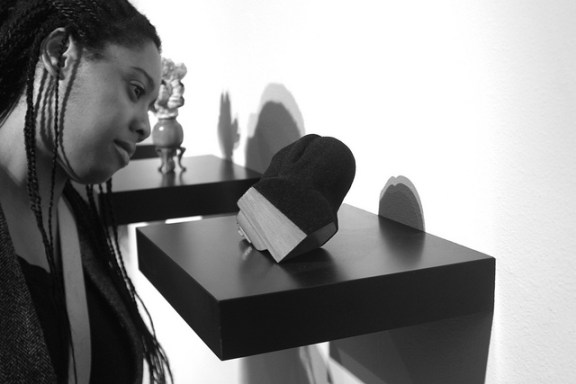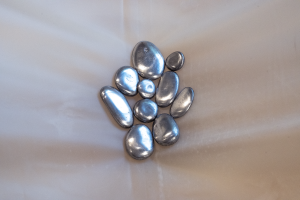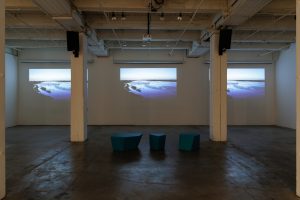Since she started with Sixty, Danielle Jackson has shown undeniable dedication to the art and artists that she chooses to write about. In her short time with us she has brought a refreshing and often playful edge to the archive through her conversations with artists like David Leggett, Michael Rea, Willy Chyr, Claire Ashley, Dutes Miller & Stan Shellabarger and Adelheid Mers. In the final days leading up to her departure to San Francisco to begin graduate school at California College of the Arts, Danielle and I sat down for brunch and revisited some of the most memorable moments of her interviews, the themes that will anchor her curatorial practice and her imagined future as the potential James Bond of the art world.
 TH: When did you realize that art was something you wanted to do as a career?
TH: When did you realize that art was something you wanted to do as a career?
DJ: I think I always knew it. But I originally started off in architecture. I got really frustrated with that, I felt really restricted because you’re designing for someone else. You’re not really doing what you want. During freshman and sophomore year you’re doing what you want, but junior year is like real life. You have all of these restrictions, and I was doing things that were very sculptural. I just didn’t love it anymore. And I was like, “Okay, I can do sculpture and do what I want.” At that point I went to Illinois State [University] and that’s what I did. [I also] I worked in the gallery as a curatorial assistant for a year. So, that’s how I got into the curatorial part, and I was always pretty good at writing.
When I left Savannah, that’s when I started to think that this art thing was serious. This is what I’m going to do.
TH: What caused the move from making to organizing and thinking about how to bring together work by other artists?
DJ: I still make. I don’t think they’re different really–architecture, sculpture and curating. They are all dealing with space. I think there’s an art to curating. Some people may approach them differently, but all the shows I really enjoy are organized in an artistic way and they’re moving you through the space in a very particular way. I don’t make a distinction between that. I think curating is an art.
TH: I agree with you on that completely.
DJ: The way you place something within a show will completely change it.
TH: I’m most intrigued by shows that are thoughtful and experimental with their layout, and ones where you can tell that the curator was really thoughtful about how someone will move through the space.
DJ: Definitely. The show that changed my life was “The Truth Is Not A Mirror: Photography as a Constructed Identity” when they had it in Bloomington. That was really good. The first photo that they had [when you enter the show] was Mickalene Thomas–one of her really large pieces. It was the first thing you saw and it drew you in. Then, there was another one–a Thomas Ruff piece which was also stunning. It really made you appreciate photography in a major way. Before that, as a sculptor, you don’t think too much about photography. But [this show] really made me respect photography because they were all so massive and stunning. And it wasn’t immediate that they were constructed either. I think it was a good move to have that Mickalene Thomas piece there because when you’d walk by the gallery you would think, “What is this? I have to go in there.”
TH: What other shows have done that for you?
DJ: I really liked the Rashid Johnson show [at the MCA] because this target symbol motif kept presenting itself in every room and I thought that was unique. In the first room it was on the floor. In the second room they didn’t really need it because they had the massive photographs, yet you could see the motifs into the third room and back into the last room. It was the very first thing I noticed on the floor. It really moved me through the show. I’m usually most interested in things that most people don’t notice–I don’t know if anyone noticed that.
TH: It’s one of those things that works at you subconsciously. I’m a believer in going to see shows multiple times because you’re not going to get everything in the first walk-through–especially if it’s subtle things.
DJ: I really enjoyed the mixture of mediums too. I liked the mirrors and the Sweetback video. I’m really into film.
TH: How do you see some of the things that have really made an imprint on your memory working their way into your own curatorial practice? You don’t yet really know what your style will be at this point, but you probably have an idea of what you’re interested in. So, what are some things you would like to investigate in your future curatorial practice?
DJ: I’m really asking myself what I feel about certain issues. I’m into Black identity, but that’s mainly linked to photography. And that photography is linked to performance–Clifford Owens, Derrick Adams, Mickalene Thomas–even if she may not think so. Photography is a growing interest of mine–but mostly as a documentation tool for performance. More so than video because with video I don’t feel like there’s the freedom to think about how this activity came about.
TH: What do you mean by that?
DJ: With video, it’s just there and you don’t have much freedom in thinking about how [the performance] was done–it’s right in front of you. But with the photograph, it’s the outcome and you can play with that and with those ideas in your head. If that makes sense at all.

TH: So, when it comes to performance you prefer photo documentation over video documentation…
DJ: Right. Even in my Stan and Dutes interview we talk about that. They don’t have documentation for the Pink Tube and a couple of other ones. And it’s really because with television we’re so used to seeing things on it to the point where we think that’s the [work], and it’s really not.
TH: It’s an ongoing question that people think about a lot–attempting to duplicate or capture the experience [a viewer gets] from the performance through the documentation. It falls short.
DJ: Photography only hints at what’s happening–but you don’t really know. So, [through photography] I can be imaginative and play with that idea a little bit. I enjoy that.
TH: What else? What other themes do you plan on investigating?
DJ: Experimentation and play. Like Claire Ashley’s stuff is all about play. Oliver Herring’s stuff is all about play. I think we need that. I like intellectual stuff and intense things, but I also need that play to balance that out. I could see myself fluxuating between the two.
TH: That brings us to some of your interviews that you’ve done with Sixty. Many of the artists you’ve interviewed strike a great balance between humor and high quality craft. That has become a thread in the artists who you’ve chosen to interview.
DJ: I don’t want to write about someone’s work that I’m not excited about. There always has to be a hint of fun and it has to be well-crafted. I don’t like bullshit, to put it bluntly. I think I got really fascinated with Michael Rea’s work but I didn’t immediately get where the humor was coming from. But when I interviewed him I got it. Interviewing him and Ryan at the same time was great–they’re really funny guys. That’s apparent in their work. And during the interviews the artists make references to other things I’m interested in. Like, I’m really interested in film–old school film in particular, which is probably why I was attracted to Ryan’s work. I’m interested in some comic book stuff–a lot of different things. So, I was looking for people that do those things. And Michael’s work is so well crafted, as a sculptor I know how hard that is and I can appreciate that. Everyone I interview I have an appreciation for their work.
TH: What are some of your most memorable interview moments?
DJ: Definitely my interview with Michael Rea–he’s just hilarious. I thought it was hilarious that he started talking about the documentary Zoo. Because I’ve been trying to figure out exactly what it is that bothered me about that film and he helped me figure that out! It really was that they romanticized the issue.
David Leggett was really cool too. We had a lot in common–I like to think that I have something in common with all of them. He went to SCAD, I went to SCAD. We talked about that. I really enjoyed all of them. With Claire Ashley we got into some serious talks about painting and I enjoyed that. And with Stan and Dutes I liked talking about Kara Walker and we had a discussion about Adrian Piper too. It’s always good to be able to talk about your ideas and develop them and get different ideas and opinions. I think they are all pretty memorable.
TH: Very democratic response…
DJ: [Laugh] Oh, and I liked Adelheid’s too–that was intense for me.
TH: Why?
DJ: Because she is so intense and articulate. It really made me think about my curatorial practice–especially what she said about curating and collateral material. Having other things outside of the exhibition as part of it. Content wise, hers was probably the best for me.
TH: With you leaving, is there anyone who you wanted to interview but didn’t get the chance to?
DJ: I wanted to interview Meg Onli of the Black Visual Archive. She does long essays–it’s a way for her to go through her own ideas. She did an Adrian Piper series that was interesting. She also did a piece on Jason Lazarus’s Emmett Till piece, which was interesting.
And Jason Lazarus would have been good too. I will do that sometime in the future.

TH: What is it about Jason’s work that you like?
DJ: It’s archival–it deals a lot with archives. I’m very interested in that. And I love his personality. With many of these people I really enjoy the type of people they are, which makes me even more interested [in their work].
TH: I’m curious, since you spent a lot of time at Illinois State University, how is the Bloomington art scene?
DJ: It’s okay. It’s good that University Galleries is there. Barry Blinderman had galleries in New York, so they always have good shows. People really respect him as a curator. Kendra and Tony are really good down there too. I’m a big fan. They’ve always had good shows, artists and curatorial talks. Outside of that, there really isn’t very much. My friend Jan is making a gallery out of one of her studios and inviting artists from Chicago and ISU graduates to exhibit there. So, there are people who are trying to change it. But I wouldn’t say it’s a focus of the time.
I don’t think it was bad. I got really interested in curating there so I can’t say that it was horrible.
TH: There are good people there and sometimes that’s all it takes. The seed just needs to be planted.
DJ: Yea. I got to interact with so many artists there. I don’t believe in coincidence. I believe everything happens for a reason. I think there was a reason why I was there with them and why I’m doing what I’m doing now. Even with Sixty, there is a reason for that. Doing the interviews really helped me figure out what I want to do in my curatorial practice and the artists I want to focus on. They are a pretty good indicator of what I’m into.
TH: If you weren’t in art, what do you imagine you would be doing?
DJ: Let me think…what would be cool? Something where I would be traveling. Can I say writing? Writing is artistic.
TH: Nope–writing doesn’t count. You could say something like a chef.
DJ: No, I wouldn’t be a chef. [laughs] This is hard! I’ve never thought about my life outside of art! Historian? Archeologist? I think my world would just suck if art wasn’t part of it. It’s everything that I know. I think I would just be miserable.
TH: Why? You wouldn’t know the difference. What if art and culture ceased to exist?
DJ: That would suck! [laugh]
TH: I know! But you would have to do something. If it helps, I think I would be an astronaut. I would want to be in outer space–though I already feel like I am in outer space. But I would really want to go out of this atmosphere–zero gravity.
DJ: I would just tour the world.
TH: You would be an international woman of mystery?
DJ: Yes! No one would know what I do. Just tour the world.
TH: Be like James Bond?
DJ: Yes! That’s exactly what I would do! Slick and cool. Australia one minute, Hong Kong the next.
TH: Well, if you were an international curator and could curate a show anywhere, where would that be?
DJ: I would go to Germany. I took three years of German and love German film. There’s something about the culture that I like. But I would also want to go somewhere really foreign to me–like Thailand–just to say I did it. I think I would go to Africa too.
TH: My last question. As you are traveling and being an international curator of mystery…
DJ: [laughs]
TH: …if you could package something from Chicago and take it with you as you travel, what would it be? To even take to the Bay area.
DJ: I really like the apartment galleries–it’s very do it yourself, which is very Chicago. I can appreciate someone saying, “The MCA doesn’t want to show my work, the Art Institute doesn’t want to show my work, so I’m going to do it myself.” I can see myself taking that with me to the Bay area–making my own way.
TH: That’s more of a way of thinking. What if you could take a physical thing with you?
DJ: The food! There’s nothing like Chicago food. If I could take the whole South Side of Chicago I would–the far south side. The South Side is so different from being downtown. It isn’t as complex, people are just living their lives.
TH: You could do that! Maybe during the winter. Though it still gets cold in the Bay, at least there’s no snow. I’m not a far south sider, but I would become one if it meant spending winters in the Bay.
DJ: …or I’d pack up and take Sixty!
Sixty will continue to follow Danielle’s adventures on the west coast, so stay tuned to find out what happens next. Until then, read up on some of her interviews with Chicago artists and curators for Sixty Inches From Center HERE.






